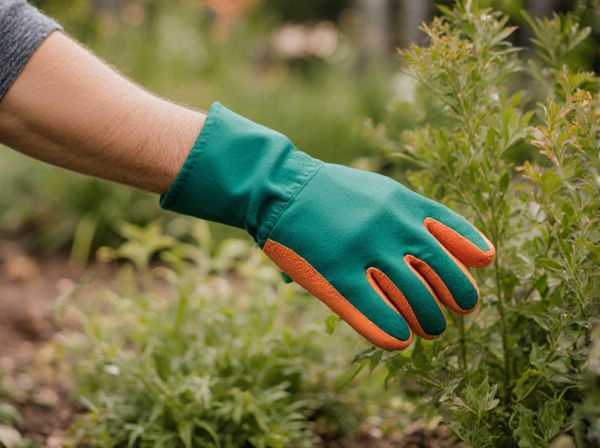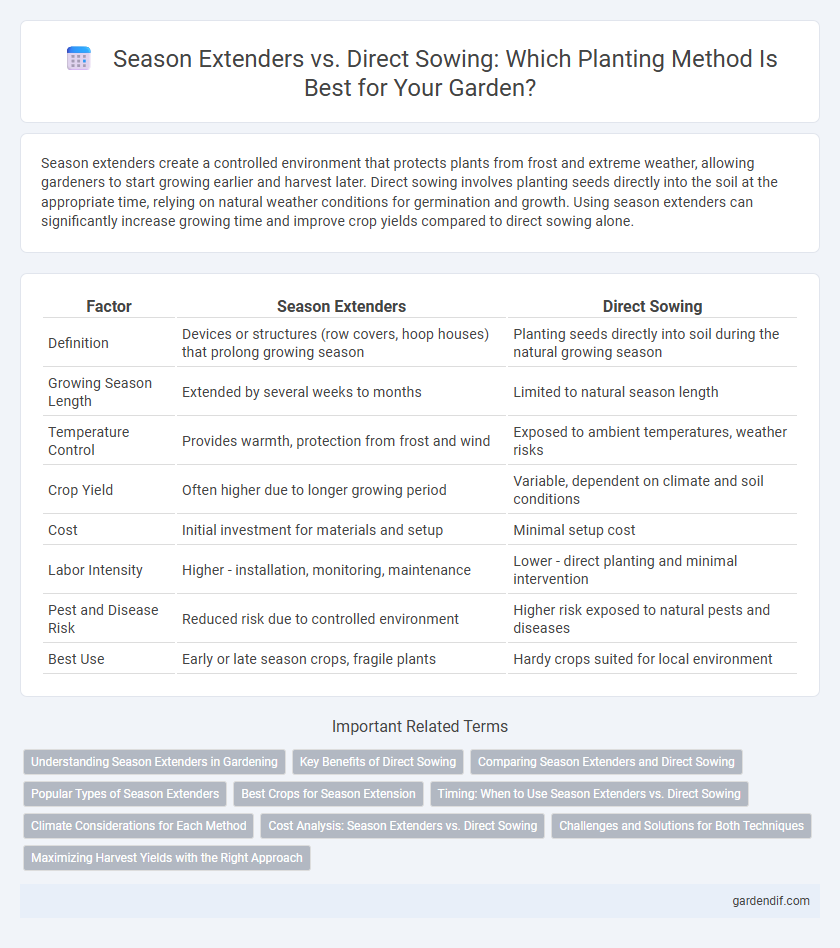
Season extenders vs Direct sowing Illustration
Season extenders create a controlled environment that protects plants from frost and extreme weather, allowing gardeners to start growing earlier and harvest later. Direct sowing involves planting seeds directly into the soil at the appropriate time, relying on natural weather conditions for germination and growth. Using season extenders can significantly increase growing time and improve crop yields compared to direct sowing alone.
Table of Comparison
| Factor | Season Extenders | Direct Sowing |
|---|---|---|
| Definition | Devices or structures (row covers, hoop houses) that prolong growing season | Planting seeds directly into soil during the natural growing season |
| Growing Season Length | Extended by several weeks to months | Limited to natural season length |
| Temperature Control | Provides warmth, protection from frost and wind | Exposed to ambient temperatures, weather risks |
| Crop Yield | Often higher due to longer growing period | Variable, dependent on climate and soil conditions |
| Cost | Initial investment for materials and setup | Minimal setup cost |
| Labor Intensity | Higher - installation, monitoring, maintenance | Lower - direct planting and minimal intervention |
| Pest and Disease Risk | Reduced risk due to controlled environment | Higher risk exposed to natural pests and diseases |
| Best Use | Early or late season crops, fragile plants | Hardy crops suited for local environment |
Understanding Season Extenders in Gardening
Season extenders like row covers, cold frames, and greenhouses provide controlled environments that protect plants from frost and temperature fluctuations, enabling gardeners to start planting earlier and harvest later. These tools improve soil warmth and moisture retention, creating optimal growing conditions beyond the traditional growing season. Unlike direct sowing, which relies solely on natural weather conditions, season extenders increase yield potential and extend the gardening calendar significantly.
Key Benefits of Direct Sowing
Direct sowing accelerates crop establishment by placing seeds directly into the soil, resulting in improved root development and stronger plants compared to season extenders like transplants. This method reduces labor and costs associated with raising seedlings indoors or in greenhouses, making it a more efficient option for large-scale farming. Direct sowing also enhances crop resilience to local soil conditions and pests, ultimately promoting sustainable agricultural practices.
Comparing Season Extenders and Direct Sowing
Season extenders such as row covers, cold frames, and hoop houses create microclimates that protect plants from frost and extend growing periods by several weeks, while direct sowing involves planting seeds directly into the soil at the appropriate time for natural growth cycles. Season extenders provide earlier starts and later harvests, offering higher yields and better control over soil temperature and moisture compared to direct sowing. However, direct sowing relies on natural weather conditions, which can result in variable germination rates and shorter growing seasons.
Popular Types of Season Extenders
Popular types of season extenders include high tunnels, cold frames, and row covers, which provide protection against frost and extend the growing season for crops. High tunnels create a controlled environment that traps heat and shields plants from harsh weather, while cold frames use solar energy to warm the soil and air. Row covers offer lightweight protection against temperature fluctuations and pests, enabling earlier planting and later harvesting compared to direct sowing.
Best Crops for Season Extension
Season extenders such as cold frames, row covers, and hoop houses allow gardeners to cultivate cold-hardy crops like kale, spinach, and radishes beyond typical growing periods. Direct sowing suits fast-maturing, frost-tolerant varieties such as lettuce and carrots, which thrive when planted directly into early or late season soil. Combining season extenders with these crops optimizes yield by protecting plants from frost while enabling continuous harvests through colder months.
Timing: When to Use Season Extenders vs. Direct Sowing
Season extenders such as row covers, cold frames, and hoop houses are ideal for early spring or late fall planting to protect seedlings from frost and extend the growing period by several weeks. Direct sowing is best suited for optimal soil temperatures, typically after the last frost date, ensuring seeds germinate and establish without the risk of cold damage. Timing the use of season extenders before or after direct sowing can maximize crop yield by bridging gaps in the growing season.
Climate Considerations for Each Method
Season extenders like row covers and greenhouses provide controlled environments that mitigate temperature fluctuations and protect crops from early frost, extending the growing season especially in cooler climates. Direct sowing relies heavily on local climate conditions, as seeds must be planted when soil temperatures reach optimal levels for germination, typically limiting this method to frost-free periods. Humidity, rainfall patterns, and risk of late frosts are critical climate factors influencing the success of each method, with season extenders offering more flexibility in variable or unpredictable climates.
Cost Analysis: Season Extenders vs. Direct Sowing
Season extenders, such as greenhouses and row covers, typically entail higher initial investments and operational costs compared to direct sowing, which mainly requires labor and seed expenses. However, the increased yield and extended harvesting periods provided by season extenders can lead to greater overall profitability, offsetting the upfront costs over time. Direct sowing offers lower short-term expenses but is more vulnerable to weather variability, potentially resulting in inconsistent crop output and revenue.
Challenges and Solutions for Both Techniques
Season extenders face challenges such as increased risk of frost damage and higher costs for materials like row covers and hoop houses, whereas direct sowing contends with unpredictable soil temperatures and pest exposure. Solutions for season extenders include using thermal blankets and automated ventilation systems to regulate microclimates, while direct sowing benefits from selecting cold-tolerant seed varieties and applying mulch to stabilize soil moisture. Both techniques require precise timing and monitoring to optimize growth cycles and maximize crop yield.
Maximizing Harvest Yields with the Right Approach
Season extenders such as row covers and cold frames create microclimates that protect crops from frost, enabling earlier planting and prolonged harvest periods. Direct sowing seeds into warmed soil allows plants to establish robust root systems naturally, often resulting in stronger growth and higher yields. Choosing the right balance between season extenders and direct sowing depends on crop type, local climate conditions, and desired harvest timing to maximize overall yield efficiency.
Season extenders vs Direct sowing Infographic

 gardendif.com
gardendif.com